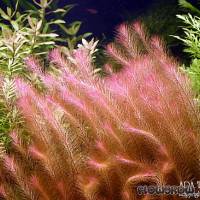
Rotala wallichii
Wallichs Rotala
Allgemein
Populärnamen [?]:
- Wallichs Rotala
- Feinblättrige Rotala
- Rotes Mooskraut
Pflanzentyp [?]:
- Stängel





Rotala wallichii ist eine elegante Stengelpflanze, die aus weichen, leicht sauren Gewässern Südostasiens stammt. Sie bildet Blütenstände mit hell leuchtenden lila Blüten aus. Obwohl sie nicht gerade einfach zu halten ist, erfreut sie sich großer Beliebtheit.
R. wallichii braucht viel Licht, CO2-Zufuhr und eine ausgewogene Nährstoffversorgung, um gut zu wachsen. Das Licht sollte mindestens bei 0,5 Watt pro Liter angesiedelt sein, um die Farben voll herauszubilden und den Wuchs zu unterstützen. Eine gute CO2-Versorgung, durch eine Bio-CO2-Anlage oder ein System mit Druckflaschen, ist unabdingbar. Diese Pflanze wächst am besten, wenn der Nitratspiegel im Wasser nicht Null erreicht, aber auch nicht höher als 10-15 mg pro Liter ansteigt. Ein hoher Phosphatgehalt von 1-2 mg pro Liter werden ebenso wie eine starke Düngung mit Eisen und Mikronährstoffen bevorzugt.
Sind die Wuchsbedingungen optimal, belohnt die Pflanze den Aquarianer mit herausragenden Farben, die von einem leuchtenden Pink, Orange bis hin zu tief roten Stengeln, mit einem Durchmesser von 2+ cm, reichen.
Diese Rotala-Art bildet opulente, feinfiedrige Gruppen, die bis zur Wasseroberfläche wachsen. Nahe der Wasseroberfläche entfaltet sie ihre intensivsten Farben und bildet die meisten Seitentriebe aus. Sobald R. wallichii zu groß wird, kann man einfach den oberen Teil abschneiden und erneut einpflanzen. Die Vermehrung geschieht ebenso durch das Abtrennen von Seitentrieben oder Kopfstecklingen. Diese neu ins Substrat eingepflanzten Stängel bilden schnell neue Wurzeln und fangen an zu wachsen.
R. wallichii wird in Naturaquarien und auch im holländischen Stil gerne wegen ihres Farbenreichtums genutzt. Sie dient dazu, schöne rote Akzente im Mittelgrund oder Hintergrund des Aquariums zu verwirklichen. Um den besten Effekt zu erhalten, sollte man 3 bis 5 Stengel gemeinsam an einen Ort einsetzen, damit sich schöne dichte Gruppen bilden.
Gestaltung
Kultur
| Licht | mittel bis hoch |
| Temperatur-Toleranz | 15 bis 30 °C |
| Temperatur-Optimum | 24 bis 28 °C |
| Karbonathärte | 0 bis 12 °dKH |
| pH-Wert | 5 bis 7 |
| Kohlendioxid (CO2) | 20 bis 40 mg/l |
| Nitrat (NO3-) | 10 bis 50 mg/l |
| Phosphat (PO43-) | 0,1 bis 3 mg/l |
| Kalium (K+) | 5 bis 30 mg/l |
| Eisen (Fe) | 0,01 bis 0,5 mg/l |
© 2006 - 2019 Flowgrow